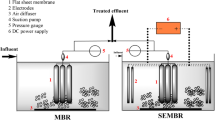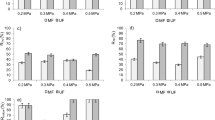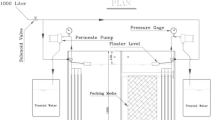Abstract
Background
Landfill leachate has been known as non-biodegradable/hardly—biodegradable wastewater, which contains significant amount of soluble organic and inorganic compounds. However, membrane bioreactor (MBR) technology have become a more viable treatment option for complex and recalcitrant compounds compared to activated sludge systems.
Methods
This study aims at evaluating the performance of anaerobic membrane bioreactor (AnMBR) for the treatment of middle/old—aged landfill leachate (LFL).AnMBR was operated at different hydraulic retention times (HRTs) (48—12 h) and relaxation and backwashing (30 min—5 min, 5 min—0.5 min) periods. Additionally, Air stripping (pH 8, 24 g lime/L, 1.4 L/s air flow rate) as a pretreatment was evaluated prior to AnMBR.
Results
Air stripping removed about 90%, 25%, and 64% NH4+, COD (Chemical Oxygen Demand) and color (RES620), respectively. The best results were obtained in combined air stripping—AnMBR operation corresponding to 95%, and 83% overall removals of color, and COD removals, respectively. Maximum methane yield and COD removal rate in AnMBR were 0.35 L methane/g COD removed and 5 gCOD removed /L.d, respectively.
Conclusion
Pretreatment provided higher AnMBR flux that reached to 5.5LMH but increased fouling frequency due to the calcium precipitates in AnMBR which was verified with SEM—EDX analysis. Additionally, DEHP and DINP were not detected in permeate indicating AnMBR was successful for removing these micropollutants. This study showed that pretreatment clearly increased methane yield and COD removal rate.




Similar content being viewed by others
References
Brito GCB, Amaral MCS, Lange LC, Pereira RCA, Santos VL, Machado M. Treatment of landfill leachate in membranes bioreactor with yeast (Saccharomyces cerevisiae). Process Eng. 2012;44:934–8.
Kjeldsen P, Barlaz MA, Rooker AP, Baun A, Ledin A, Christensen TH. Present and long-term composition of MSW landfill leachate: a review. Critical Reviews in Enviro Sci and Technol. 2002;32(4):297–336.
Tahmasbizadeh M, Amouei AI, Golbaz S, Farzadkia M, Kermani M, Gholami M, Asgharnia H. Simultaneous removal of chemical oxygen demand (cod) and ammonium from landfill leachate using anaerobic digesters. 2015; 33–39.
Barnes KK, Kolpin DW, Furlong ET, Zaugg SD, Meyer MT, Barber LB. A national reconnaissance of pharmaceuticals and other organic wastewater contaminants in the United States—I Groundwater. Sci Total Enviro. 2008;402(2–3):192–200.
Buszka PM, Yeskis DJ, Kolpin DW, Furlong ET, Zaugg SD, Meyer MT. Waste-indicator and pharmaceutical compounds in landfill-leachate-affected ground water near Elkhart, Indiana, 2000–2002. Bulletin Enviro Contamination Toxi. 2009;82(6):653–9.
Eggen T, Moeder M, Arukwe A. Municipal landfill leachates: a significant source for new and emerging pollutants. Sci Tot Enviro. 2010;408(21):5147–57.
Chen X, Xu S, Tan T, Lee S, Cheng S, Lee F, et al. Toxicity and estrogenic endocrine disrupting activity of phthalates and their mixtures. Int J Enviro Res Public Health. 2014;11:3156–68.
Sari H, Yetilmezsoy K, Ilhan F, Yazici S, Kurt U, Apaydin O. Fuzzy-logic modeling of Fenton’s strong chemical oxidation process treating three types of landfill leachates. Enviro Sci Pollu Resear. 2013;20(6):4235–53.
Klikowska D, Klimiuk E. The effect of landfill age on municipal leachate composition. Bioresour Technol. 2008;94:5981–5.
Öztürk İ, Çevre, T.C., Müdürlüğü, OBÇYG. 2010. Atık Sektörü Mevcut Durum Değerlendirmesi Raporu.TC. Çevre ve Orman Bakanlığı Çevre Yönetimi Genel Müdürlüğü, Ankara, Türkiye.
Bilad MR, Declerck P, Piasecka A, Vanysacker L, Yan X, Vankelecom IF. Treatment of molasses wastewater in a membrane bioreactor: influence of membrane pore size. Sep Purif Technol. 2011;78(2):105–12.
Visvanathan C, Ben Aim R, Parameshwaran K. Membrane separation bioreactors for wastewater treatment. Crit Rev Env Sci Technol. 2000;30:1–48.
Yang S, Yang F, Fu Z, Wang T, Lei R. Simultaneous nitrogen and phosphorus removal by a novel sequencing batch moving bed membrane bioreactor for wastewater treatment. J Hazard Mater. 2010;175(1–3):551–7.
Duan L, Tian Z, Song Y, Jiang W, Tian Y, Li S. Influence of solids retention time on membrane fouling: characterization of extracellular polymeric substances and soluble microbial products. Biofouling. 2015;31:181–91.
Deng L, Guo W, Ngo HH, Zhang HJ, Wang J, Li S, et al. Biofouling and control approaches in membrane bioreactors. Bioresour Technol. 2016;221:656–65.
Meng F, Zhang S, Oh Y, Zhou Z, Shin HS, Chae SR. Fouling in membrane bioreactors: an updated review. Water Res. 2017;114:151–80.
Le-Clech P, Chen V, Fane TA. Fouling in membrane bioreactors used in wastewater treatment. J Memb Sci. 2006;284(1–2):17–53.
Huang Z, Ong SL, Ng HY. Submerged anaerobic membrane bioreactor for low-strength wastewater treatment: effect of HRT and SRT on treatment performance and membrane fouling. Water Res. 2011;45(2):705–13.
Lowry OH, Rosebrough NJ, Farr AL, Randall RJ. Protein measurement with the Folin phenol reagent. J Biol Chem. 1951;193(1):265–75.
Hu L, Zeng G, Chen G, Dong H, Liu Y, Wan J, et al. Treatment of landfill leachate using immobilized Phanerochaete chrysosporium loaded with nitrogen-doped TiO2nanoparticles. J. Hazard. Subst. 2016;301:106–18.
Boonnorat J, Chiemchaisri C, Chiemchaisri W, Yamamoto K. Removals of phenolic compounds and phthalic acid esters in landfill leachate by microbial sludge of two-stage membrane bioreactor. J. Hazard. Subst. 2014;277:93–101.
Wichitsathian B, Sindhuja S, Visvanathan C, Ahn KH. Landfill leachate treatment by yeast and bacteria based membrane bioreactors. J Environ Sci Health A Tox Hazard Subst Environ. 2004;39(9):2391–404.
Ferraz FM, Povinelli J, Vieira EM. Ammonia removal from landfill leachate by air stripping and absorption. Environ Technol. 2013;34(15):2317–26.
Gotvajn AZ, Tisler T, Zagorc-Koncan J. Comparison of different treatment strategies for industrial landfill leachate. J Hazard Subst. 2009;162(2–3):1446–56.
Setiadi T, Fairus S. Hazardous waste landfill leachate treatment using an activated sludge-membrane system. Water Sci Technol. 2003;48(8):111–7.
Xie Z, Wang Z, Wang Q, Zhu C, Wu Z. An anaerobic dynamic membrane bioreactor (AnDMBR) for landfill leachate treatment: performance and microbial community identification. Bioresour Technol. 2014;161:29–39.
Bohdziewicz J, Neczaj E, Kwarciak A. Landfill leachate treatment by means of anaerobic membrane bioreactor. Desali. 2008;221(1–3):559–65.
Yeo H, An J, Reid R, Rittmann BE, Lee HS. Contribution of liquid/gas mass-transfer limitations to dissolved methane oversaturation in anaerobic treatment of dilute wastewater. Enviro. Sci. Technol. 2015;49(17):10366–72.
Xie K, Lin HJ, Mahendran B, Bagley DM, Leung KT, Liss SN, et al. Performance and fouling characteristics of a submerged anaerobic membrane bioreactor for Kraft evaporator condensate treatment. Enviro Sci Technol. 2010;31(5):511–21.
Qin J, Joo MH, Tao G, Kekre KA. Feasibilitystudy on petrochemical wastewater treatment and reuse using submerged MBR. J Membr Sci. 2007;293(1–2):161–6.
Chang JS, Chang CY, Chen AC, Erdei L, Vigneswaran S. Long-termoperation of submerged membrane bioreactor for the treatment of high strength acrylonitrile-butadiene-styrene (ABS) wastewater: effect of hydraulic retention time. Desali. 2006;191(1–3):45–51.
Duan L, Jiang W, Song Y, Xia S, Hermanowicz SW. The characteristics of extracellular polymeric substances and soluble microbial products in moving bed biofilm reactor-membrane bioreactor. Bioresour Technol. 2013;148:436–42.
Ozgun H, Gimenez JB, Ersahin ME, Tao Y, Spanjers H, Van Lier JB. Impact of membrane addition for effluent extraction on the performance and sludge characteristics of upflow anaerobic sludge blanket reactor streating municipal wastewater. J Membr Sci. 2015;479:95–104.
Bouhabila EH, Aim RB, Buisson H. Fouling characterization in membrane bioreactors. Sep Purif Technol. 2001;22:123–32.
Jarusutthirak C, Amy G. Role of soluble microbial products (SMP) in membrane fouling and flux decline. Enviro. Sci. Technol. 2006;40(3):969–74.
Geng Z, Hall ER. A comparative study of fouling-related properties of sludge from conventional and membrane enhanced biological phosphorus removal processes. WaterRes. 2007;41(19):4329–38.
Zhu H, Han Y, Ma W, Han H, Ma W. Removal of selected nitrogenous heterocyclic compounds in biologically pretreated coal gasification wastewater (BPCGW) using the catalytic ozonation process combined with the two-stage membrane bioreactor (MBR). Bioresour Technol. 2017;245:786–93.
Sima XF, Wang YY, Shen XC, Jing XR, Tian LJ, Yu HQ, et al. Robust biochar-assisted alleviation of membrane fouling in MBRs by indirect mechanism. Sep Purif Technol. 2017;184:195–204.
Zhang H, Fan X, Wang B, Song L. Calcium ion on membrane fouling reduction and bioflocculation promotion in membrane bioreactor at high salt shock. Bioresour Technol. 2016;200:535–40.
Chen K, Wang X, Li X, Qian J, Xiao X. Impacts of sludge retention time on the performance of submerged membrane bioreactor with the addition of calcium ion. Sep Purif Technol. 2011;82:148–55.
Kim IS, Jang N. The effect of calcium on the membrane biofouling in the membrane bioreactor (MBR). Water Res. 2006;40(14):2756–64.
Arabi S, Nakhla G. Impact of calcium on the membrane fouling in membrane bioreactors. J Membr Sci. 2008;314(1–2):134–42.
Miao R, Li X, Wu Y, Wang P, Wang L, Wu G, et al. Comparison of the roles of Ca2+ and Mg2+ on membrane fouling with humic acid: are there any differences or similarities. J Membr Sci. 2018;545:81–7.
Xu Y, Zhou Y, Wang D, Chen S, LIU J, Zijian W. Occurrence and removal of organic micropollutants in the treatment of landfill leachate by combined anaerobic-membrane bioreactor technology. J Enviro Sci. 2008;20(11):1281–7.
Fang C, Chu Y, Jiang L, Wang H, Long Y, Shen D. Removal of phthalic acid diesters through a municipal solid waste landfill leachate treatment process. J Mater Cycles Waste. 2018;20(1):585–91.
Acknowledgements
This work was funded by Scientific Research Project Coordination Unit of Kahramanmaras Sutcu Imam University (Project No: 2017/1—34 YLS).
Author information
Authors and Affiliations
Corresponding author
Ethics declarations
Conflict of interest
The authors declare no conflict of interest.
Additional information
Publisher’s note
Springer Nature remains neutral with regard to jurisdictional claims in published maps and institutional affiliations.
Rights and permissions
About this article
Cite this article
Cirik, K., Gocer, S. Performance of anaerobic membrane bioreactor treating landfill leachate. J Environ Health Sci Engineer 18, 383–393 (2020). https://doi.org/10.1007/s40201-019-00376-9
Received:
Accepted:
Published:
Issue Date:
DOI: https://doi.org/10.1007/s40201-019-00376-9




